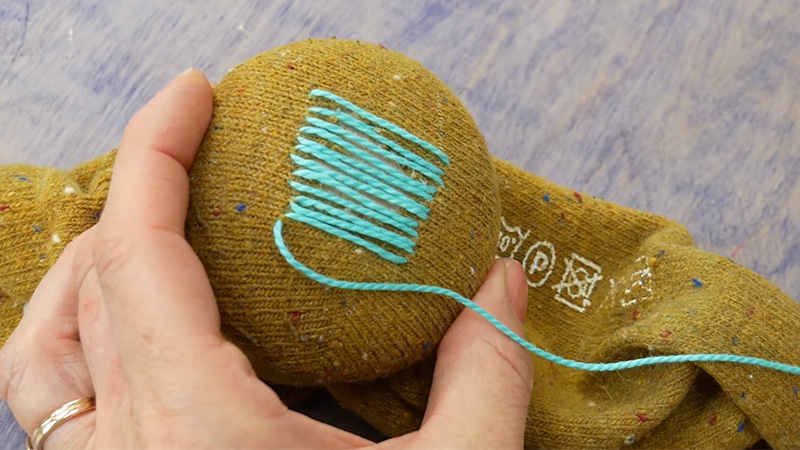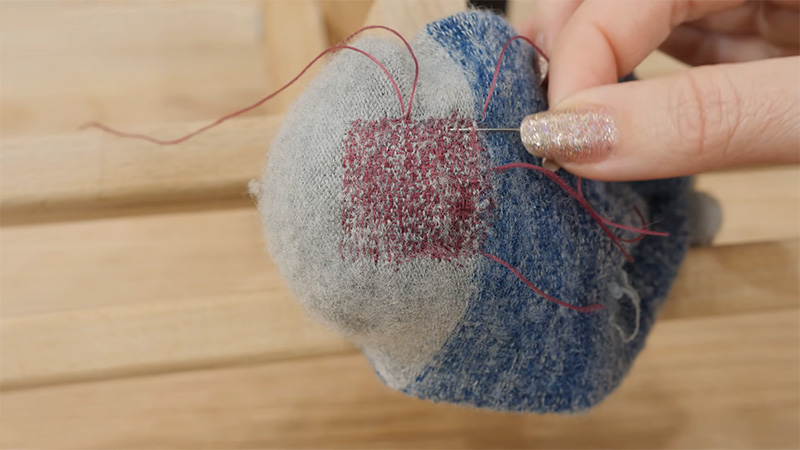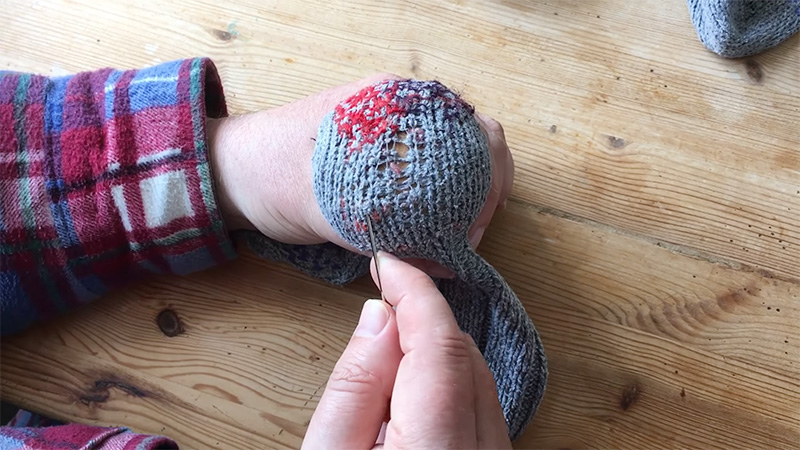Darning a sock is a time-honored skill that marries practicality with sustainability. In a world where disposable items often take precedence, learning how to darn a sock is an invaluable endeavor.
Socks, those trusty companions of our daily lives, are prone to wear and tear, but they need not meet an untimely end. Darning, the art of repairing and reinforcing socks, not only prolongs their lifespan but also embodies the principles of resourcefulness and eco-consciousness.
This comprehensive guide on how to darn a sock will equip you with essential techniques and methods to mend those beloved socks that have served you well.
From basic darning with a needle and thread to more intricate methods, each step will be demystified, empowering you to embark on a journey of sustainable sock care.

How to Darn a Sock?
Darning a sock is a valuable skill that can extend the life of your favorite pair. Here are the simple methods for darning a sock:
Basic Darning with Needle and Thread:
Thread a needle with matching or contrasting yarn and weave it through the worn area, creating a grid-like pattern. This method reinforces the sock and closes small holes.
Running Stitch Darn:
Use a running stitch to cover the hole evenly. This method is quick and efficient for small holes and minor damage.
Duplicate Stitch Darn:
Duplicate stitch, also known as Swiss darning, involves embroidering over the hole with a matching yarn. It mimics the sock’s original knit pattern, making the repair nearly invisible.
Weaving Darn:
Weaving darn creates a sturdy patch by weaving a piece of thread or yarn horizontally and vertically through the damaged area. It’s suitable for larger holes and worn-out sections.
Patch Darning:
Attach a fabric patch to the sock’s underside using a whipstitch or running stitch. This method is ideal for covering extensive damage while maintaining comfort.
Circular Darning for Toe Holes:
Repair holes at the toe by creating a circular patch using a darning egg or a curved surface as a guide. This technique maintains the sock’s shape and comfort.
Latch Hook Darn:
Latch hook darning utilizes a latch hook tool to secure yarn loops through the sock’s damaged area, effectively covering holes and preventing further damage.
These methods offer a range of options for darning socks, from quick fixes to more intricate repairs. By choosing the most appropriate technique for the damage at hand, you can keep your socks in good condition and reduce waste.
Is It Worth It To Darn Socks?

Darning socks may seem like a quaint and time-consuming practice, but it holds significant importance for several reasons:
Economical:
Darning socks is a cost-effective way to extend their lifespan, saving you money on frequent sock replacements. It’s a sustainable choice that reduces textile waste.
Environmental Impact:
Repairing and reusing socks contributes to reducing the environmental impact of textile production and disposal. It conserves resources and minimizes landfill waste.
Preservation of Favorite Socks:
Some socks hold sentimental value or have unique features that are hard to replace. Darning allows you to continue enjoying your favorite pairs.
Skill Development:
Darning is a valuable sewing skill that enhances your crafting abilities. It provides a sense of accomplishment and self-sufficiency as you repair your items.
Sustainable Living:
Repairing everyday items aligns with the principles of sustainable living. It promotes responsible consumption and encourages a mindset of making the most of what you have.
Personal Connection:
Darning fosters a deeper connection with your belongings. Repairing your socks by hand allows you to appreciate the craftsmanship and effort that goes into each item.
Reduction of Clothing Waste:
By darning socks and other clothing, you contribute to reducing the overall amount of discarded textiles, which can have a positive impact on the environment.
Darning socks is worth the effort, as it aligns with sustainability principles, saves money, and allows you to continue enjoying your favorite items. It also promotes valuable skills and a more mindful approach to consumption, ultimately benefiting both you and the environment.
What Thread Do You Use To Darn Socks?

Darning socks effectively requires choosing the right thread for the job. Here are the kinds of threads commonly used for darning:
Sewing Thread:
Standard sewing thread, available in a variety of colors, can be used for basic darning. It’s suitable for minor repairs and small holes in socks.
Embroidery Floss:
Embroidery floss is a thicker, colorful thread that works well for decorative darning or reinforcing larger holes. It adds a touch of creativity to your repairs.
Wool Yarn:
Wool yarn is an excellent choice for darning wool or wool-blend socks. It blends seamlessly with the sock’s fibers and provides warmth and comfort.
Cotton Yarn:
Cotton yarn is ideal for darning cotton socks. It’s lightweight and breathable, making it a good choice for summer or lightweight sock repairs.
Nylon Thread:
Nylon thread is a strong and durable option for darning socks made from synthetic materials like nylon or polyester. It’s resistant to wear and tear.
Linen Thread:
Linen thread is a natural fiber option that can be used for darning. It’s strong and durable, making it suitable for sock repairs that require extra strength.
Specialized Darning Thread:
Some brands offer specialized darning thread designed specifically for repairing socks. These threads often come in a variety of colors and are easy to work with.
Choosing the right thread depends on the type of sock, the extent of the damage, and your personal preferences. Always consider the sock’s fabric composition and the desired aesthetics when selecting thread for darning.
FAQs
Why should I bother darning socks instead of buying new ones?
Darning socks is a sustainable practice that reduces textile waste and saves money. It also allows you to extend the life of your favorite socks and minimize your environmental footprint.
Can I darn socks with large holes or extensive damage?
Yes, you can. The method may vary, but darning can effectively repair even socks with significant damage, ensuring they remain wearable.
What kind of thread should I use for darning socks?
The choice of thread depends on the sock’s fabric composition. Common options include sewing thread, embroidery floss, wool yarn, and nylon thread.
Are darning socks difficult for beginners?
Darning is a skill that can be learned by beginners. Start with simple methods, and as you gain experience, you can tackle more complex repairs.
Are there any special tools required for sock darning?
Basic darning can be done with a needle, thread, and a darning egg or mushroom to maintain the sock’s shape. However, specialized tools are not always necessary for minor repairs.
Conclusion
In a world that often favors convenience and disposability, the act of darning a sock is a small but significant rebellion.
As we conclude this guide on how to darn a sock, it’s evident that this practice extends beyond mere sock repair. It symbolizes an ethos of sustainability, resourcefulness, and mindful consumption.
By mastering the art of sock darning, you contribute to reducing textile waste, saving money, and embracing the values of craftsmanship. You preserve the stories embedded in each pair of socks, making them a testament to your skill and dedication.
So, let your socks bear the marks of care and repair, and may they continue to accompany you on many more journeys, warmed by your love and attention.
Leave a Reply